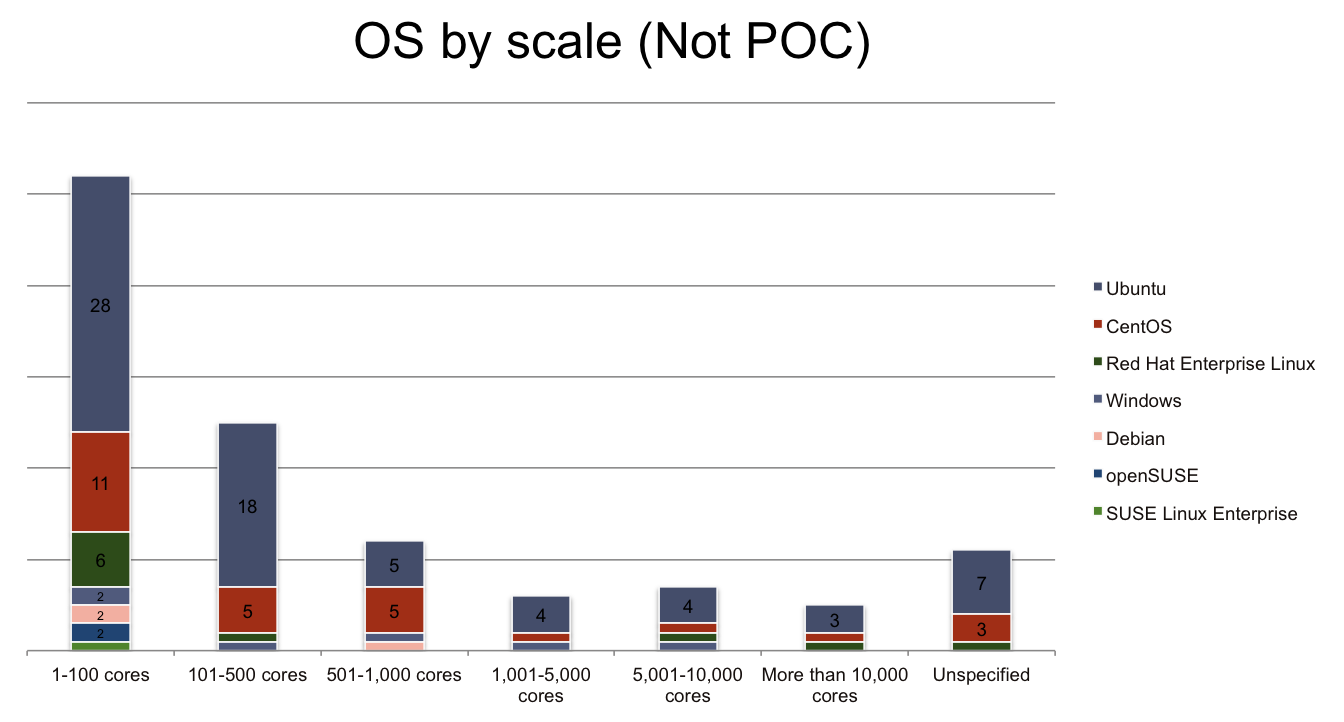Among the several reasons for Red Hat to embrace CentOS, its erstwhile copycatting nemesis, one explanation has largely been overlooked: The cloud made them do it. More specifically, OpenStack made them do it.
Red Hat had all but sewn up the market for Linux in the data center. But in the cloud, the market for Linux is both wide open—and perhaps nonexistent.
OpenStack Loves Freedom
OpenStack polls its user base every few months to see which technologies are popular on the open-source cloud platform. The most recent results from October show strong adoption for Ubuntu and CentOS, and very little for Red Hat Enterprise Linux (RHEL):

While this dominance of free overpaid OSes diminishes as the deployment size grows, it remains a fact of life even at 10,000 cores. I’m sure the alarm bells were ringing in Raleigh, North Carolina, where Red Hat is headquartered, when these results were reported.
Not only do the results suggest users are less likely to pay for an OS in the cloud, but they might also indicate an interest among developers to remove barriers to get more stuff done. Ubuntu and CentOS don’t require purchasing approval or the clearing of any bureaucratic hurdles like Red Hat does.
Does The OS Matter In The Cloud?
None of these minor issues would matter if the OS were still critical infrastructure. Red Hat, for its part, insists the OS is more relevant than ever:
[I]n order for end users to benefit from a cloud platform that supports balanced workloads that can scale in a secure manner, the operating system has to be designed to enhance that cloud platform.
One of the most significant requirements for companies adopting cloud computing is the need to adopt a hybrid approach to computing. To do so, most organizations will continue to maintain their traditional data center to support complex mixed workloads….Therefore, it is more important than ever for the operating system to support and federate the various computing deployment models so they appear to be a single system from a customer experience and a systems and service management perspective.
Others, however, argue that in a world of Platform as a Service (PaaS), the OS doesn’t matter much anymore. It depends on the workload, of course, but the trend is clearly toward developers writing to cloud platforms, not specifically to an OS—especially one they have to pay for.
Red Hat is likely correct that many enterprises will want to stitch together hybrid workloads that span data center and cloud, but it’s unclear that enterprises are going to want to continue to pay in the same way they have.
Embracing Cloud Disruption
So Red Hat embraced its clone, as well as the cloud platform OpenStack. As Red Hat CEO Jim Whitehurst told me in an interview recently, Red Hat’s “core value is to ensure our customers have flexibility to run their applications wherever they want to run them,” whether that’s on OpenStack or Amazon Web Services or data centers or… wherever.
Importantly, Whitehurst doesn’t see Red Hat becoming Oracle:
There are a lot of people that want Red Hat to be the Oracle of open source, buying up an entire stack (database, BI, etc.). In all honesty, really good companies know their source of competitive advantage and focus on it. This doesn’t mean you don’t look to expand that source of advantage, but you need to exploit the strengths you have.
To Whitehurst, Red Hat’s strength is in providing open infrastructure that allows enterprises to run applications wherever they make the most sense. And while this may mean that enterprises will worry less about the OS and instead care more about the cloud, Red Hat is moving “up the stack,” as it were, to support this shift to the cloud.
Will it work? Maybe. Red Hat can no longer depend upon its Linux dominance to contend for workloads in the cloud, but if it can be to OpenStack what it has been to the Linux kernel, Red Hat has a fighting chance.









